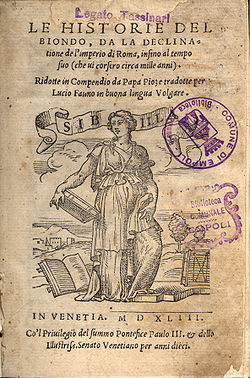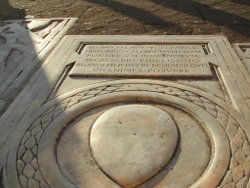
Flavio Biondo
Encyclopedia

Renaissance humanism
Renaissance humanism was an activity of cultural and educational reform engaged by scholars, writers, and civic leaders who are today known as Renaissance humanists. It developed during the fourteenth and the beginning of the fifteenth centuries, and was a response to the challenge of Mediæval...
historian. He was one of the first historians to used a three-period division of history (Ancient, Medieval, Modern) and is known as one of the first archaeologist
History of archaeology
The history of archaeology has been one of increasing professionalism, and the use of an increasing range of techniques, to obtain as much data on the site being examined as possible.-Origins :...
s.
Born in the capital city of Forlì
Forlì
Forlì is a comune and city in Emilia-Romagna, Italy, and is the capital of the province of Forlì-Cesena. The city is situated along the Via Emilia, to the right of the Montone river, and is an important agricultural centre...
, in the Romagna
Romagna
Romagna is an Italian historical region that approximately corresponds to the south-eastern portion of present-day Emilia-Romagna. Traditionally, it is limited by the Apennines to the south-west, the Adriatic to the east, and the rivers Reno and Sillaro to the north and west...
region, Flavio was well schooled from an early age, studying under Ballistario of Cremona. During a brief stay in Milan, he discovered and transcribed the unique manuscript of Cicero
Cicero
Marcus Tullius Cicero , was a Roman philosopher, statesman, lawyer, political theorist, and Roman constitutionalist. He came from a wealthy municipal family of the equestrian order, and is widely considered one of Rome's greatest orators and prose stylists.He introduced the Romans to the chief...
's dialogue Brutus. He moved to Rome
Rome
Rome is the capital of Italy and the country's largest and most populated city and comune, with over 2.7 million residents in . The city is located in the central-western portion of the Italian Peninsula, on the Tiber River within the Lazio region of Italy.Rome's history spans two and a half...
in 1433 where he began work on his writing career; he was appointed secretary to the Cancelleria under Eugene IV
Pope Eugene IV
Pope Eugene IV , born Gabriele Condulmer, was pope from March 3, 1431, to his death.-Biography:He was born in Venice to a rich merchant family, a Correr on his mother's side. Condulmer entered the Order of Saint Augustine at the monastery of St. George in his native city...
in 1444 and accompanied Eugene in his exile, in Ferrara and Florence. After his patron's death, Flavio was employed by his papal successors, Nicholas V
Pope Nicholas V
Pope Nicholas V , born Tommaso Parentucelli, was Pope from March 6, 1447 to his death in 1455.-Biography:He was born at Sarzana, Liguria, where his father was a physician...
, Callixtus III
Pope Callixtus III
Pope Callixtus III , né Alfons de Borja, was Pope from April 8, 1455 to his death in 1458.-Biography:...
and the great humanist Pius II
Pope Pius II
Pope Pius II, born Enea Silvio Piccolomini was Pope from August 19, 1458 until his death in 1464. Pius II was born at Corsignano in the Sienese territory of a noble but decayed family...
.
Archaeological works
Flavio published three encyclopedic works that were systematic and documented guides to the ruins and topography of ancient RomeTopography of ancient Rome
The topography of ancient Rome is a multidisciplinary field of study that draws on archaeology, epigraphy, cartography and philology.The classic English-language work of scholarship is A Topographical Dictionary of Ancient Rome , written by Samuel Ball Platner, completed and published after his...
, for which he has been called one of the first archaeologists; subsequent antiquaries and historians built on the foundations laid down by Flavio and by his older contemporary, Poggio Bracciolini.
At the time the ruins of ancient Rome were overgrown and unexplored. When in 1430 Bracciolini climbed the Capitol
Capitoline Hill
The Capitoline Hill , between the Forum and the Campus Martius, is one of the seven hills of Rome. It was the citadel of the earliest Romans. By the 16th century, Capitolinus had become Capitolino in Italian, with the alternative Campidoglio stemming from Capitolium. The English word capitol...
he saw only deserted fields. The Forum
Roman Forum
The Roman Forum is a rectangular forum surrounded by the ruins of several important ancient government buildings at the center of the city of Rome. Citizens of the ancient city referred to this space, originally a marketplace, as the Forum Magnum, or simply the Forum...
, buried in eroded topsoil, was grazed by cows—the Campo Vaccino— and pigs rooted in its unweeded vegetation. Flavio and fellow humanists like Leone Battista Alberti
Leone Battista Alberti
Leon Battista Alberti was an Italian author, artist, architect, poet, priest, linguist, philosopher, cryptographer and general Renaissance humanist polymath...
began to explore and document the architecture, topography and history of Rome, and in the process revived a vision of Rome's former glory.

Topography
Topography is the study of Earth's surface shape and features or those ofplanets, moons, and asteroids...
. It was and remains a highly influential humanist vision of restoring Rome to its previous heights of grandeur by recreating what Rome used to look like based on the ruins which remained. This work was the first systematic and well documented guide to the ruins of Rome, or indeed any ancient ruins, and he has thus been called one of the first archaeologists.
The second was the highly popular De Roma triumphante (Rome Triumphant, (1459)) about pagan
Paganism
Paganism is a blanket term, typically used to refer to non-Abrahamic, indigenous polytheistic religious traditions....
Rome as a model for contemporary governmental and military reforms. The book was highly influential in reviving Roman patriotism and respect for ancient Rome, while presenting the papacy as a continuation of the Roman Empire
Roman Empire
The Roman Empire was the post-Republican period of the ancient Roman civilization, characterised by an autocratic form of government and large territorial holdings in Europe and around the Mediterranean....
.
Historical works
Biondo's greatest works were Italia illustrata (Italy Illuminated, written between 1448 and 1458, published 1474) and the Historiarum ab inclinatione Romanorum imperii decades (Decades of History from the Deterioration of the Roman Empire, written from 1439 to 1453, published in 1483).The Italia illustrata (1474) is a geography, based on the author's personal travels, and history of eighteen Italian provinces. Unlike medieval geographers, whose focus was regional, Biondo, taking Strabo
Strabo
Strabo, also written Strabon was a Greek historian, geographer and philosopher.-Life:Strabo was born to an affluent family from Amaseia in Pontus , a city which he said was situated the approximate equivalent of 75 km from the Black Sea...
for his model, reinstated the idea of Italy to include the whole of the peninsula. Through topography, he intended to link Antiquity with modern times, with descriptions of each location, the etymology of its toponym and its changes through time, with a synopsis of important events connected with each location. This first historical geography starts with the Roman Republic and Empire, through 400 years of barbarian invasions and an analysis of Charlemagne
Charlemagne
Charlemagne was King of the Franks from 768 and Emperor of the Romans from 800 to his death in 814. He expanded the Frankish kingdom into an empire that incorporated much of Western and Central Europe. During his reign, he conquered Italy and was crowned by Pope Leo III on 25 December 800...
and later Holy Roman Emperor
Holy Roman Emperor
The Holy Roman Emperor is a term used by historians to denote a medieval ruler who, as German King, had also received the title of "Emperor of the Romans" from the Pope...
s. He gives an excellent description of the humanist revival and restoration of the classics during the first half of the fifteenth century.
Flavio's greatest work is the Historiarum ab Inclinatione Romanorum Imperii (Venice, 1483), a history of Europe in thirty-two books, from the plunder of Rome in 410 by the Visigoths, to contemporary Italy (1442). Using only the most reliable and primary sources, it used a three-period framework, with Italy reviving in Biondo's own time and breaking free of earlier trends. Leonardo Bruni
Leonardo Bruni
Leonardo Bruni was an Italian humanist, historian and statesman. He has been called the first modern historian.-Biography:...
also used a three-period framework in History of the Florentine People, written at about the same time as Biondo's work.
Sources
- Rome Restored, Edited by Marc Laureys and William McCuaig, English translation, To be announced.
- "Flavio Biondo". In Encyclopædia BritannicaEncyclopædia BritannicaThe Encyclopædia Britannica , published by Encyclopædia Britannica, Inc., is a general knowledge English-language encyclopaedia that is available in print, as a DVD, and on the Internet. It is written and continuously updated by about 100 full-time editors and more than 4,000 expert...
Online. - "Flavio Biondo" in Catholic EncyclopediaCatholic EncyclopediaThe Catholic Encyclopedia, also referred to as the Old Catholic Encyclopedia and the Original Catholic Encyclopedia, is an English-language encyclopedia published in the United States. The first volume appeared in March 1907 and the last three volumes appeared in 1912, followed by a master index...
(1907). - Castner, Catherine J. (ed., trans., comm.). Biondo Flavio's Italia illustrata: Text, translation, and commentary. Vol. I: Northern Italy. (Binghamton, NY: Global Academic Publishing, 2005).
- J. A. White (ed., trans.), Biondo Flavio, Italy Illuminated. Vol. 1: Books I-IV. (Cambridge, MA: Harvard University Press, 2005) (The I Tatti Renaissance Library, 20).
Latin texts online
- De Origine et Gestis Venetorum (part of the Opera Basel 1531)
- Historiae Ab Inclinatione Romanorum Imperii (part of the Opera Basel 1531)
- Historiarum ab inclinatione romanorum imperii (Venice: Octavianus Scotus, 1483; Hain *3248)
- In Romam Instauratam
- Roma Instaurata (part of the Opera Basel 1531)
- Italia Illustrata (part of the Opera Basel 1531)
- Triumphans Roma (part of the Opera Basel 1531)

